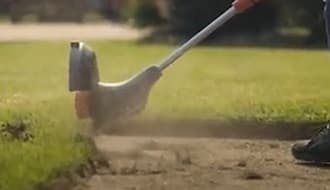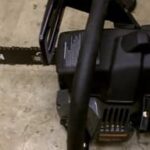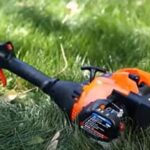As an Amazon Associate, this site earns commissions from qualifying purchases. For more information click here.
Small engines need to be primed before you can use them, and string trimmers are no exception. The primer moves fuel from the tank into the carburetor, so if there is any problem in that area, the engine will not run.
A damaged primer bulb will prevent a string trimmer from starting. A dirty fuel filter, faulty fuel tank or worn out gas seals can also stop fuel from getting into the primer. Replacing the damaged part will fix the problem.
This post will cover the most common causes and offer the solutions. Before you start, keep the string trimmer’s manual nearby for guidance. Since you will be handling the fuel, wear safety gear and keep flammable objects away.
Damaged Primer Bulb
As the name suggests, the primer bulb is the bulb-shape you see on string trimmers. Its function is to supply gas to the carburetor. You do this by pushing the bulb down a few times.
It might take several presses before the primer bulb starts. If nothing happens when you press the bulb, do it repeatedly up to 12 times. If the engine still won’t prime, the bulb is probably broken.
This problem occurs less in high quality string trimmers. The Husqvarna 324L 4-Cycle string trimmer is built so that these kinds of problems are minimized.
Check the bulb for cracks. These damages can arise from heavy usage or just get worn out with age. If the plastic is torn or looks ready to crack, get a replacement which are readily available.
Primer bulbs also have lines that draw fuel into the carburetor. These lines can get tangled, pulled, loose or worn out. Inspect the lines if there is trouble. You might be able to fix the thing if it is just tangled, but get a replacement if the line has clogged up.
Broken Fuel Tank
Check the fuel tank for holes, cracks or clogging. Any of these is enough to prevent the engine from priming.
Clogging. This usually happens when old fuel has been left in the tank. When gas is more than four weeks old, it dissipates and leaves behind a sticky residue. This substance clogs the tank and prevents whatever fuel is left from reaching the carburetor.
If the tank is covered with residue, clean it thoroughly with Star Brite or another similar product. Drain the tank to ensure no fuel is left When all that is left is the residue, remove it with a fuel deposit cleaner.
Check the tank for signs of damage, cracks, wear etc. If there is none, pour new fuel. Two-stroke trimmers require a 40:1 mix of oil and gas. A four-stroke engine does not mix the two. Check your owner’s manual if you are not sure.
Cracks and holes. Replace the fuel tank or take the trimmer to a repair service center. No patch up job is going to fix this problem. A crack in the fuel tank means gas is going to leak, which is dangerous.

Worn Out Fuel Lines
The fuel line gets frayed through constant use. Eventually the line reaches a point it can no longer function. Without a working fuel line there is no way to prime the fuel. If the fuel line is old and worn, buy a new one.
How to replace a string trimmer fuel line:
- Shut the engine down.
- Drain all the fuel from the tank.
- Open the fuel tank. Get a pair of needle nose pliers and pull the fuel line out. You have to remove the fuel filter as well. Usually you need to replace the fuel line and filter at the same time.
- Install the new fuel line and filter.
- Pour new fuel into the tank. Clean the tank first if necessary.
- Plug the primer line into the carburetor.
- Push the primer bulb. The fuel will flow into the engine and run.
- The fuel line might be connected to other parts aside from the carburetor. Note where the lines are connected as that is where you need to put the new fuel line.
This video shows you how it is done step by step.
Defective Gas Seal
The seal around the tank is designed to contain the fuel. If the seal is damaged the gas could leak and cause other problems.
If the seal is broken, gas is going to leak out. Instead of fuel going into the primer it ends up seeping outside the machine. This limits the amount of fuel that goes into the engine and can prevent the primer bulb from working. Even if the primer bulb is functional, it cannot stop gas from leaking.
Related. Why your string trimmer is leaking gas
A defective gas seal needs to be fixed or replaced as soon as possible. When you open the gas tank, look at the seals and if there are any problems with it.
Blocked Carburetor
If the fuel lines are clean and functional, the problem may be with the carburetor. In most string trimmers, the carburetor is located under the air filter cover. It is also close to the primer bulb itself.
The best case scenario is the carburetor just needs cleaning. If that does not work, it might have to be replaced. To find out, follow these steps.
Use a pair of needle pliers and remove the fuel lines.
Turn your weed eater upside down. If gas seeps out, the fuel lines are damaged and have to be replaced. If fuel does not drop, the trouble is with the carburetor.
Remove the air filter cover and the filter.
You should be able to see the carburetor now. If it is covered with dirt, carbon deposits and old fuel, clean it.
After cleanup, turn the trimmer on. If the engine still won’t prime, the carburetor might have to be replaced.
Fuel Filter Needs Replacement
The fuel filter keeps debris and dirt out of the system. If contaminated fuel gets into the engine, it will cause short and long term problems. The engine might not start and the fuel won’t prime instance. The long term issue is that the contaminants will wear out engine parts.
Fuel filters are usually replaced, not cleaned. Replacements are cheap and it is easier to buy a new one than go through the trouble of cleaning.
If you want to clean the fuel filter, open the tank and carefully remove the filter. It should be right there close to the fuel lines.
Once you take the filter out, check for signs of wear and tear. If the filter is damaged you have to get a new one. If it is just dirty, give it a good cleanup.
Turn the trimmer on when you are finished. If the engine fuel does not prime, you need to get a replacement.
How to Prevent String Trimmer Fuel Problems
A lot of issues with fuel can be prevented or minimized with the right approach. Keep these guidelines in mind as they are good for all types of weed eaters.
Replace the fuel every 30 days. Some suggest 90 days, but 30 is better. If you leave fuel for long periods, it will turn into a sticky substance and clog the engine.
If you are not going to use the trimmer for several months, empty the fuel tank. Or at least put fuel stabilizer in the tank.
Small engines are either 2-stroke or 4-stroke. A 2-stroke string trimmer requires a mix of gas and oil. The standard ratio is 40:1 though some models use 50:1 or 32:1. Check your owner’s manual for information.
If you put the wrong mix ratio, drain the tank and pour fresh fuel. Do not worry that you wasted gas. It will be much worse if you try to run the trimmer on the wrong fuel mix.
Unless the owner’s manual says otherwise, the best fuel for string trimmers is regular unleaded with no more than 10% ethanol. If you can get ethanol-free fuel that’s great, but it is not necessary.
Remember that a faulty primer bulb is the first sign of priming issues. The fastest solution is to replace the bulb. You can order one through the manufacturer website.

I love the outdoors and all the tools for maintaining gardens, yards and lawns. The only thing I am more passionate about is sharing what I know about garden and outdoor equipment.


